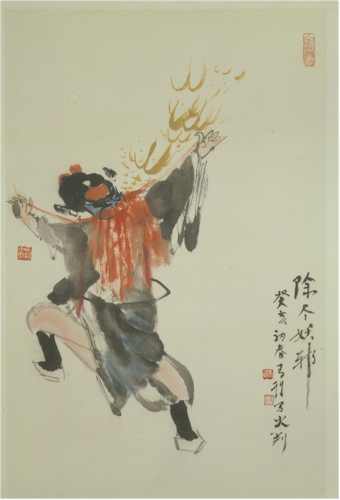For example, no over effort
is made to represent the shadows cast by a
particular type of lighting at a certain place
and time in the clothing on people depicted in
the Sung dynasty painting Che K'an T'u, and for
this reason the painting does not have a clear
three-dimensional effect. After the painter set
the lines down on the paper, he used watercolor
wash techniques to achieve a chiaroscuro effect
of light and dark, representing the forces of
"yin" and "yang", to express his grasp of the
eternal quintessential nature of of his subject.
A square planter painted according to the
objective principles of perspective should in
theory appear longer in front and be
foreshortened in the back, reflecting the
perceived decrease in relative size of more
distant objects. But the front and back edges of
a real planter are equal in length, and this
knowledge of the physical world is incorporated
into the image the painter of the Che K'an T'u
created: the planter is represented as a flat
surface with slides that are equal in length. quintessential nature of of his subject.
A square planter painted according to the
objective principles of perspective should in
theory appear longer in front and be
foreshortened in the back, reflecting the
perceived decrease in relative size of more
distant objects. But the front and back edges of
a real planter are equal in length, and this
knowledge of the physical world is incorporated
into the image the painter of the Che K'an T'u
created: the planter is represented as a flat
surface with slides that are equal in length.
In another work, called
the "Splash-ink Immortal", by Sung dynasty
artist Liang K'ai, the artist wanted to portray
not just any man off the street, but an
other-worldly recluse, and thus it would have
been inappropriate to use an ordinary human
being as a model. The highly unusual, even
weird, forms in this painting, with their bold
and unbridled brush strokes, provide just the
right background to set off the characteristics
of this very extraordinary individual. This
painting is representative of the "freehand
brushstroke" school of traditional Chinese
painting.
The fundamental component
of Chinese painting is the line, as it is in
Chinese calligraphy. Because of this shared
feature, these two arts have had, beginning from
a very early time, a close mutual relationship.
By the time that literati painting had become
popular in the Yuan dynasty, men of letters who
painted put even more conscious effort into
reaffirming the link to Chinese calligraphy, and
actively led a trend to fuse calligraphy, and
actively led a trend to fuse calligraphy and
painting. And the close relationship between
poetry and painting was formed under the strong
influence of literature on painting.
Scholar-statesmen and literati led the melding
of poetry and painting, and this eventually
spread to the academy of painting. The Sung
Empror Hui Tsung is known to have used poetry to
test painters on their ability to express with
ink and paper the enchanted world created in
written verse.
While traditional Chinese
painting still occupies an important place in
the life of modern Chinese, many painters now
desire to express their experience of new times.
By combining new modes of expression with
traditional Chinese painting techniques, they
are opening up a vast, new world of artistic
expression.
Go Back |


 quintessential nature of of his subject.
A square planter painted according to the
objective principles of perspective should in
theory appear longer in front and be
foreshortened in the back, reflecting the
perceived decrease in relative size of more
distant objects. But the front and back edges of
a real planter are equal in length, and this
knowledge of the physical world is incorporated
into the image the painter of the Che K'an T'u
created: the planter is represented as a flat
surface with slides that are equal in length.
quintessential nature of of his subject.
A square planter painted according to the
objective principles of perspective should in
theory appear longer in front and be
foreshortened in the back, reflecting the
perceived decrease in relative size of more
distant objects. But the front and back edges of
a real planter are equal in length, and this
knowledge of the physical world is incorporated
into the image the painter of the Che K'an T'u
created: the planter is represented as a flat
surface with slides that are equal in length.